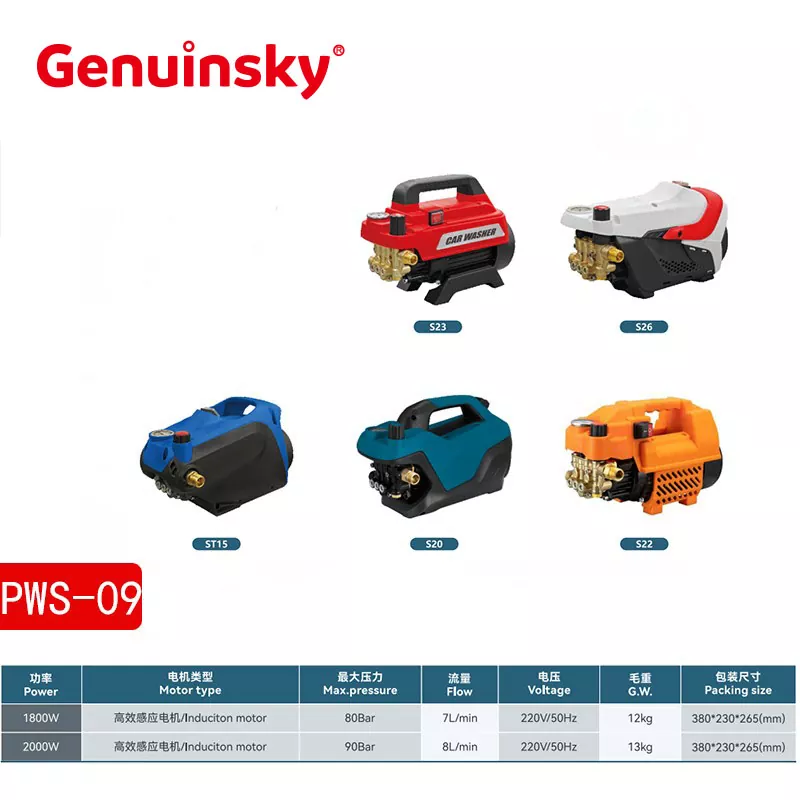Misunderstandings to avoid when using high-pressure water guns
2025-06-20
High-pressure water guns are powerful and efficient tools widely used for various cleaning applications, from washing vehicles and cleaning patios to removing paint and debris from industrial surfaces. However, their effectiveness can be diminished—and even become hazardous—if misunderstood or misused. Many users, especially beginners, operate high-pressure washers under certain misconceptions that can lead to equipment damage, personal injury, or poor cleaning results. This essay explores common misunderstandings to avoid when using high-pressure water guns, aiming to promote safer and more effective usage.
1. "More Pressure Means Better Cleaning"
One of the most common misconceptions is that the higher the pressure, the better the cleaning performance. While pressure (measured in PSI—pounds per square inch) is an important factor, using excessive pressure on the wrong surfaces can cause damage. For example, blasting a car’s paintwork with a 0° nozzle at full power can chip the paint or dent the surface. Similarly, wooden decks or delicate siding may splinter or erode under high pressure. Effective cleaning requires the right balance of pressure and flow rate, matched to the surface and type of dirt. Choosing the correct nozzle and adjusting the pressure setting are more important than simply maximizing power.
2. "All Nozzles Work the Same"
Another misunderstanding is assuming that all nozzles perform the same function. In reality, each nozzle is designed with a specific spray angle and use case in mind. For instance, a red 0° nozzle delivers a very narrow, highly concentrated jet that is ideal for removing tough stains but can be dangerous if used on people or fragile surfaces. A white 40° nozzle, on the other hand, spreads water over a wider area with less intensity, making it better for washing cars or windows. Misusing a nozzle not only leads to ineffective cleaning but also increases the risk of injury or property damage. Understanding the color-coded nozzle system and choosing the correct spray angle is essential for safe and effective operation.

3. "You Can Use It on Any Surface"
Many users mistakenly believe that high-pressure water guns are safe for use on all surfaces. In reality, certain materials, such as softwood, old paint, asphalt shingles, and electrical components, can be seriously damaged by high-pressure water. Spraying water into vents, electrical outlets, or fragile seals can cause water ingress, leading to mold, corrosion, or electrical failure. Users must assess the material’s resistance to pressure and consult product manuals or surface care guidelines before use. Testing on a small, inconspicuous area first is always a wise precaution.
4. "Protective Gear Is Optional"
Due to their convenience, some users underestimate the risks associated with high-pressure water guns. Water exiting a high-pressure nozzle can cause cuts, bruises, or even deep puncture wounds, especially at close range. Flying debris, ricocheted water, and chemicals mixed with water can also pose hazards. Failing to wear safety gear such as goggles, gloves, and appropriate footwear is a common and dangerous oversight. Even short-term exposure can result in injuries or accidents. Personal protective equipment (PPE) should always be worn when operating high-pressure water guns.
5. "Detergents Are Unnecessary or All the Same"
Another common misconception is that detergents are either optional or universally interchangeable. In fact, using the correct cleaning agent can significantly enhance results, particularly for oily or greasy stains. Additionally, not all detergents are compatible with pressure washers. Some may clog the system or damage internal components. It’s important to use pressure washer–approved detergents and to apply them using the appropriate low-pressure soap nozzle. Rinsing thoroughly afterward is also essential to avoid residue or surface damage.
6. "Any Water Source Will Do"
Some users assume that any water source, such as a pond or pool, can be connected to a pressure washer. However, many pressure washers require clean, pressurized water to function properly. Using water with high sediment or debris content can clog nozzles, wear down internal parts, and reduce efficiency. If an alternative water source must be used, a proper filtration system should be installed to protect the machine. Furthermore, ensuring adequate water flow and pressure from the source is critical to maintaining performance and avoiding pump damage.
7. "Maintenance Isn’t Important"
Neglecting maintenance is a frequent oversight that can shorten the lifespan of a high-pressure water gun. Users often forget to clean the nozzles, check for hose leaks, or inspect the machine for wear. Over time, buildup of mineral deposits or grime can lead to poor performance or even complete system failure. Regular maintenance—such as flushing the system after use, storing it properly, and inspecting parts—is essential for keeping the machine in good condition and ensuring safety.
Conclusion
High-pressure water guns are powerful cleaning tools that can make difficult tasks faster and more efficient. However, their proper use requires a clear understanding of their operation, limitations, and safety precautions. Misunderstandings such as assuming higher pressure is always better, ignoring nozzle differences, or using them on inappropriate surfaces can lead to damaged property, personal injury, or inefficient cleaning. By avoiding these common pitfalls, users can make the most of their high-pressure washers while preserving safety, equipment durability, and surface integrity. Responsible and informed use ensures the tool remains a valuable asset for years to come.
As a professional manufacturer and supplier, we provide high-quality products. If you are interested in our products or have any questions, please feel free to contact us.


